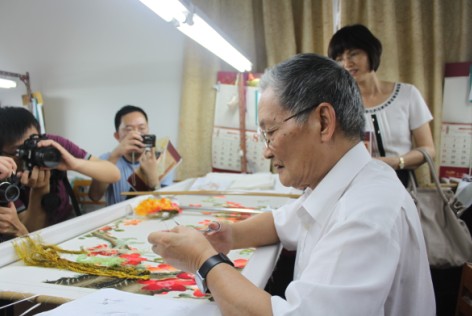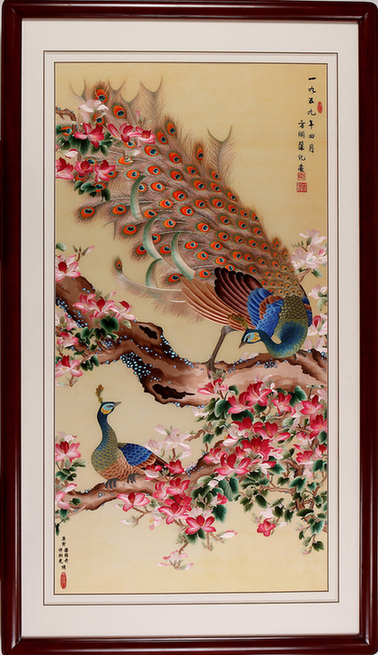Society
Plight of traditional Chinese embroidery
Updated: 2011-08-15 10:04
By Yan Weijue (chinadaily.com.cn)
Slowly and carefully, 79-year-old Xu Chiguang performs needlework stitches on embroidery. The goose pattern on the silk fabric opens its wings, making it look very vivid. But the embroidery master knows it is much more difficult to keep another thing alive – traditional Guangdong embroidery industry.
 |
|
Xu Chiguang shows Guangdong embroidery skills at a workshop at the Guangzhou Embroidery Craftwork Factory Co Ltd in Guangzhou, Aug 14, 2011. [Photo/chinadaily.com.cn] |
Boasting a history of more than a thousand years, Guangdong embroidery has been well-known for its gorgeous color, distinct contrasts, graphic patterns, vivid imagery, well-conceived designs and diverse needle technique. Its prime was in the 1950s, when there were more than 3,500 artists and over 60,000 professional workers who devoted themselves to the business in Guangdong province. The Xinjiao Embroidery Cooperative (the predecessor of Guangzhou Embroidery Craftwork Factory Co Ltd), founded in 1955, was among a large number of embroidery art factories throughout the province.
Things began to fall apart in late 1960s, when operations in all of the embroidery art factories were brought to a standstill. With craftsmen changing their careers one by one, the industry never returned to its prime stature.
"Most of them had turned to other businesses for life, which left the embroidery industry in an embarrassing situation. The output dropped sharply due to the lack of producers in the early 1970s, when we resumed the operation in the factory," said Huang Zhiwen, Party secretary of the Guangzhou Embroidery Craftwork Factory Co Ltd.
The massive machinery operation then pushed traditional embroidery art, which is hand-made, to the verge of extinction.
 |
|
Embroidery work by Xu Chiguang and Liang Guikai, both of whom are embroidery masters. [Photo provided to chinadaily.com.cn] |
"We definitely could not compete with machines, so we got more and more short-handed, which resulted in poor production. It was kind of a vicious circle," Huang said. "Even worse, Xu Chiguang's retirement in 1993 turned out to be the last straw to the collapse, leading to a 10-year shutdown of the company."
I was not until 2003 that the company declared its second comeback, after combined efforts by company authorities, as well as the Guangzhou government.
Xu Chiguang and other embroidery masters came out of retirement at the invitation of company authorities and set up examples aimed at a revival that would last much longer than before.
"The senior artists started to get involved in the enrollment of rookies. Each of them apprenticed around 10 beginners," Huang said. "They all knew the torch had to be passed on."
At the same time, the government realized the importance of the cultural preservation.
"The Guangzhou government allocated a 1.2 million yuan ($187,800) fund for the company's development in 2009 and 2010. We used the money to bring in several spray machines to improve the efficiency of the work," said Zhang Jingwen, an employee with the company. "And they (government) and some large enterprises purchased decent amounts as gifts for guests or cooperative partners. That is a big boost for the sales."
Currently the company's annual sales volume stands at 3 million yuan and its 50-something employees are all ages.
"In addition, we've kept in touch with some painters in the province, inviting them to design for the embroidery pieces."

Specials

Star journalist leaves legacy
Li Xing, China Daily's assistant editor-in-chief and veteran columnist, died of a cerebral hemorrhage on Aug 7 in Washington DC, US.

Robots seen as employer-friendly
Robots are not new to industrial manufacturing. They have been in use since the 1960s.

Smurfs up in China
The movie remake of a classic 1980s cartoon series is expected to have special cross-generation appeal to Chinese filmgoers